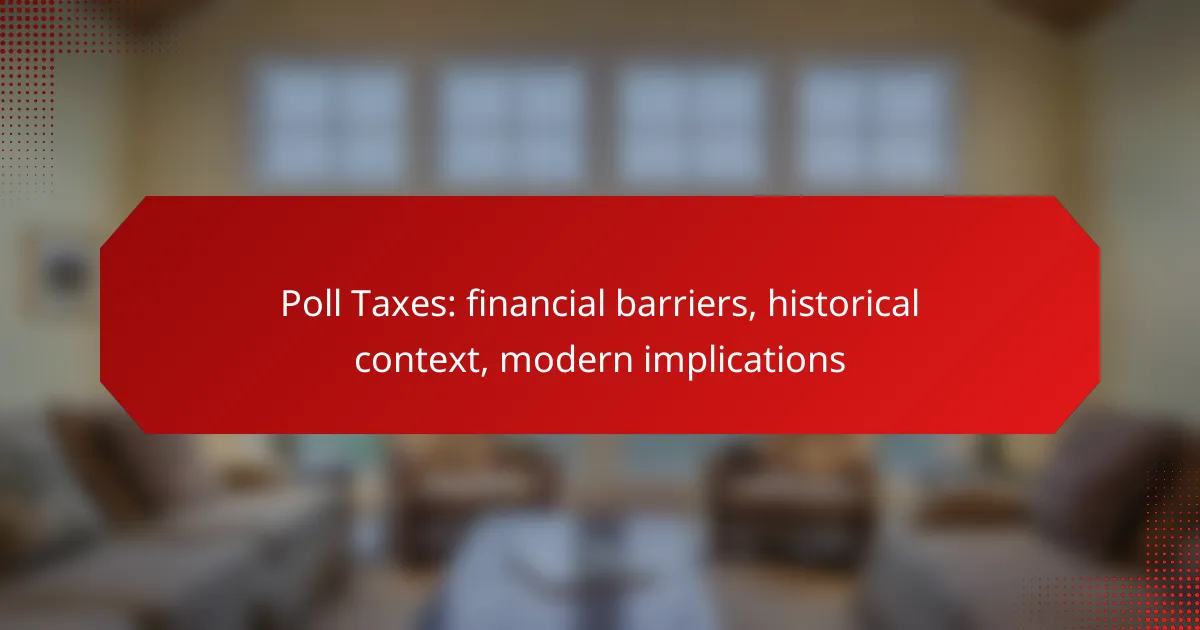Poll taxes represent a financial hurdle for voters, disproportionately impacting low-income individuals and hindering their participation in elections. Originating in the post-Civil War era as a means to restrict voting rights for marginalized groups, these taxes have left a lasting legacy that continues to influence contemporary discussions about voting access and equity. Despite being abolished in the U.S., the implications of poll taxes remain relevant as society grapples with modern financial barriers to democratic engagement.
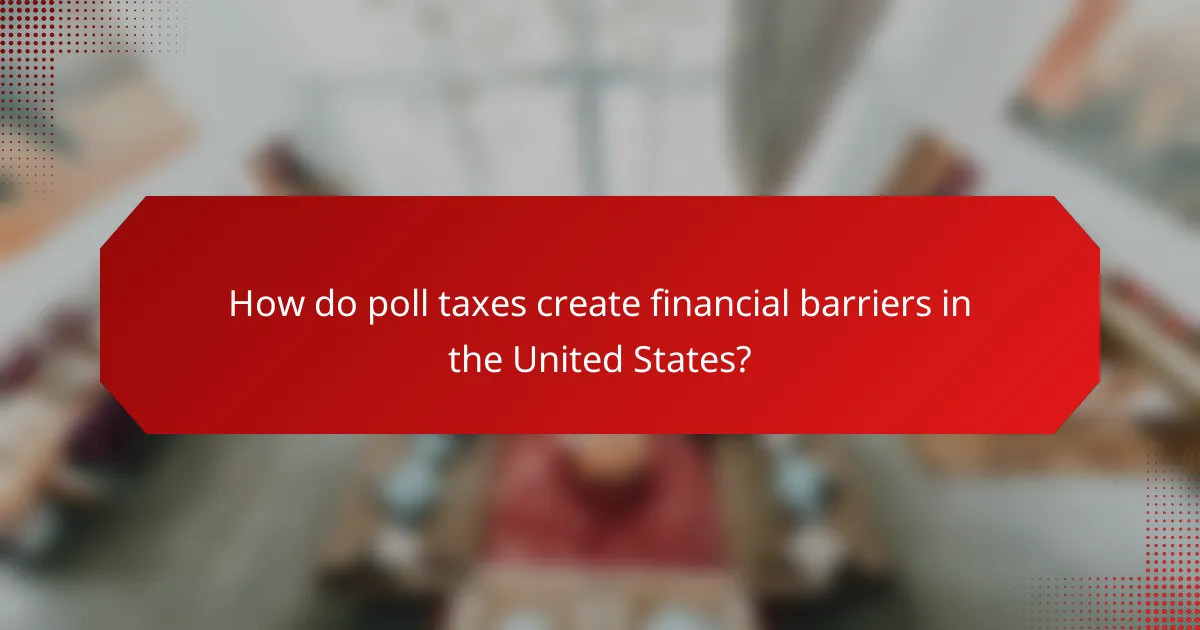
How do poll taxes create financial barriers in the United States?
Poll taxes impose a financial requirement on voters, creating significant barriers for those who struggle to afford them. This fee can deter low-income individuals from participating in elections, thereby undermining democratic engagement.
Impact on low-income voters
Low-income voters face substantial challenges due to poll taxes, as these fees can consume a significant portion of their limited resources. Even a small amount, such as $10 to $50, can be a barrier for those living paycheck to paycheck, leading to decreased voter turnout.
Many low-income individuals may prioritize essential expenses like housing and food over voting costs, resulting in a lower representation of their interests in the political arena. This financial barrier can perpetuate a cycle of disenfranchisement and inequality.
Disproportionate effects on minority communities
Poll taxes disproportionately affect minority communities, which often experience higher rates of poverty. Historical and systemic inequalities mean that these groups are more likely to struggle with the financial burden of voting fees.
As a result, minority voters may be less likely to participate in elections, further marginalizing their voices in political decision-making. This exclusion can perpetuate policies that do not address their specific needs and challenges.
Historical context of economic inequality
The history of poll taxes in the United States is rooted in efforts to disenfranchise marginalized populations, particularly in the South. Introduced in the late 19th century, these taxes were often coupled with literacy tests and other discriminatory practices aimed at suppressing African American voters.
Understanding this historical context highlights the ongoing economic inequalities that persist today. While poll taxes were abolished federally in the 1960s, the legacy of financial barriers continues to impact voter participation among low-income and minority communities.
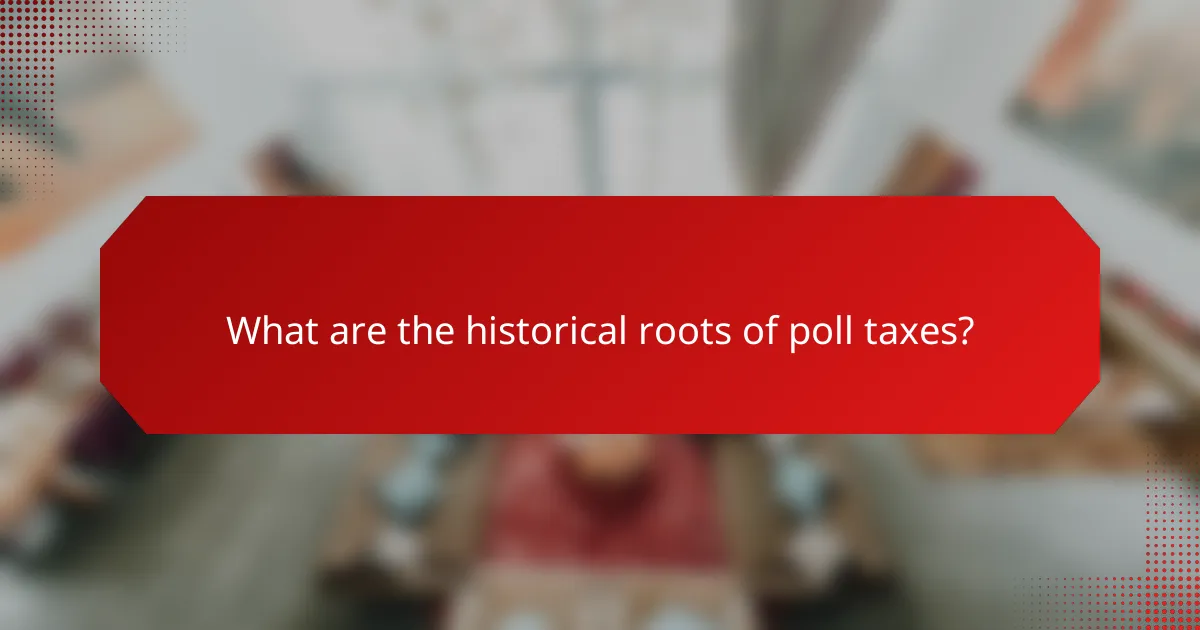
What are the historical roots of poll taxes?
Poll taxes originated as a financial barrier to voting, primarily affecting marginalized groups. Their historical roots trace back to the post-Civil War era, where they were implemented to restrict voting rights, particularly among African Americans and poor whites.
Origin in the Reconstruction era
Poll taxes emerged during the Reconstruction era as Southern states sought to reassert control after the Civil War. These taxes were introduced as a means to disenfranchise newly freed African Americans, who often lacked the financial means to pay such fees.
The Reconstruction Amendments aimed to secure voting rights for all citizens, but poll taxes effectively undermined these protections. By imposing a financial requirement, states could legally exclude those who could not afford to pay, thereby maintaining white supremacy in the electoral process.
Implementation in Southern states
Southern states adopted poll taxes in various forms throughout the late 19th and early 20th centuries. The fees varied significantly, often set at amounts that were prohibitively expensive for low-income individuals, typically ranging from one to several dollars.
In addition to the financial burden, states implemented literacy tests and other discriminatory practices alongside poll taxes. This combination further entrenched systemic barriers, making it exceedingly difficult for marginalized groups to participate in elections.
Legal challenges and Supreme Court rulings
Poll taxes faced numerous legal challenges over the years, culminating in significant Supreme Court rulings. In 1966, the Court ruled in Harper v. Virginia Board of Elections that poll taxes in state elections were unconstitutional, citing violations of the Equal Protection Clause.
This ruling was a pivotal moment in the civil rights movement, as it invalidated the use of poll taxes as a means to restrict voting access. Subsequently, the 24th Amendment, ratified in 1964, prohibited poll taxes in federal elections, reinforcing the principle of free and fair voting for all citizens.
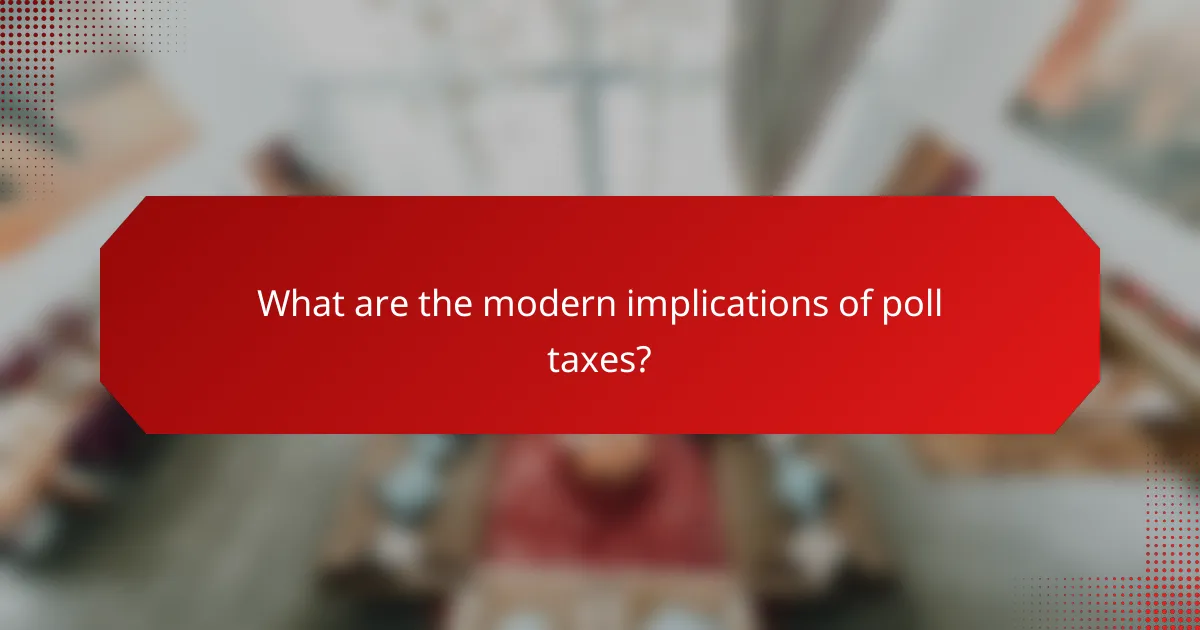
What are the modern implications of poll taxes?
Modern implications of poll taxes include ongoing discussions about financial barriers to voting and their potential to disenfranchise certain populations. Although poll taxes were abolished in the U.S., their legacy influences current voting rights issues, particularly regarding access and equity in the electoral process.
Current voting rights debates
Current voting rights debates often center around access to the ballot and the impact of financial requirements on voter participation. Many advocates argue that any form of payment required to vote, even indirectly, can disproportionately affect low-income individuals and marginalized communities. This has led to calls for more inclusive policies that ensure every citizen can vote without financial barriers.
Legislative efforts in various states reflect these concerns, with some proposing measures to eliminate fees associated with voter registration or voting itself. These discussions are crucial as they shape the future of democratic participation and equity in the electoral system.
Connection to voter ID laws
Voter ID laws are often linked to the legacy of poll taxes, as both can create obstacles for certain voters. While voter ID requirements aim to prevent fraud, they can also serve as a financial barrier, especially if obtaining an ID incurs costs. This connection raises questions about the fairness and accessibility of voting processes.
Critics argue that voter ID laws disproportionately impact low-income individuals, similar to the effects of poll taxes. As states continue to implement these laws, the debate over their necessity and impact on voter turnout remains heated.
Impact on civic engagement
The legacy of poll taxes continues to influence civic engagement by highlighting the importance of accessible voting. When financial barriers exist, they can discourage participation in elections, leading to lower voter turnout among affected groups. This can create a cycle of disenfranchisement that undermines democratic processes.
Efforts to enhance civic engagement must address these barriers by promoting policies that facilitate easier access to voting. Initiatives such as public awareness campaigns and community outreach programs can help mitigate the impact of financial obstacles, encouraging broader participation in the electoral process.
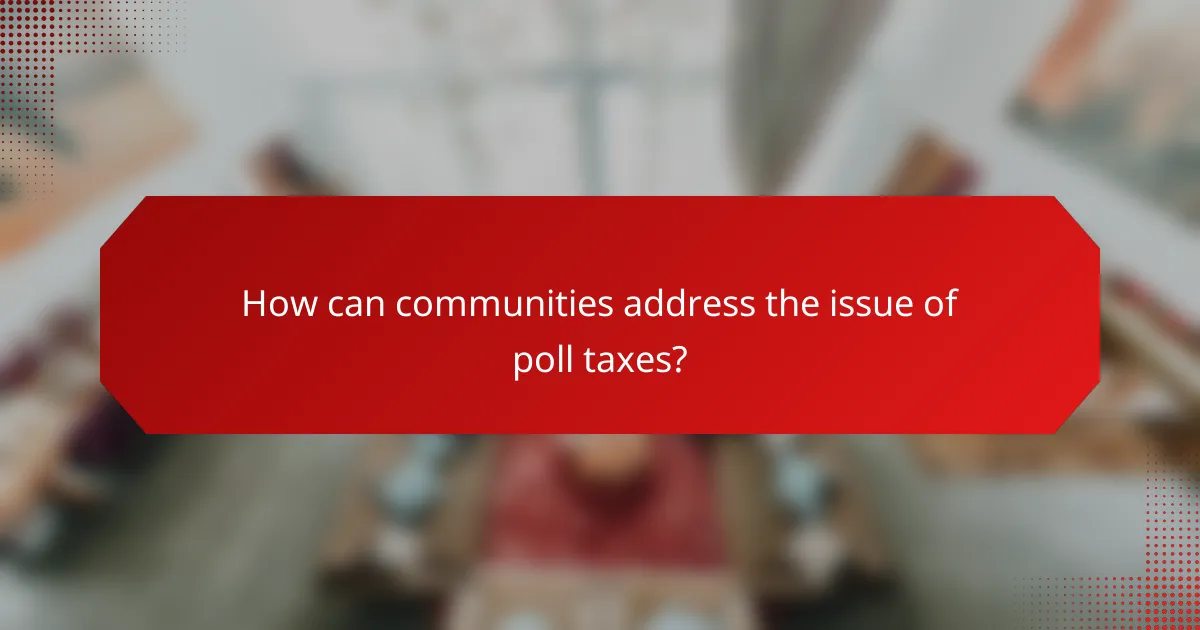
How can communities address the issue of poll taxes?
Communities can tackle the issue of poll taxes by advocating for legislative reforms, educating residents about their rights, and forming partnerships with civil rights organizations. These strategies can help eliminate financial barriers to voting and promote equitable access to the electoral process.
Advocacy for legislative change
Advocating for legislative change involves pushing for laws that eliminate poll taxes and other financial barriers to voting. Communities can organize campaigns to lobby local and state lawmakers, highlighting the negative impact of such taxes on voter participation.
Engaging with policymakers can also include presenting data and personal stories that illustrate how poll taxes disproportionately affect low-income individuals and marginalized groups. Mobilizing community members to contact their representatives can amplify the call for reform.
Community education initiatives
Community education initiatives focus on informing residents about their voting rights and the historical context of poll taxes. Workshops, seminars, and informational materials can help demystify the voting process and empower individuals to advocate for themselves.
Utilizing local media, social media platforms, and community centers can enhance outreach efforts. Providing clear, accessible information about how to register to vote and the implications of poll taxes can increase awareness and participation.
Partnerships with civil rights organizations
Forming partnerships with civil rights organizations can strengthen community efforts to combat poll taxes. These organizations often have the resources, expertise, and networks necessary to effectively advocate for change and support local initiatives.
Collaborating on events, campaigns, and educational programs can amplify the message and reach a broader audience. Additionally, these partnerships can provide legal assistance and advocacy support for individuals facing challenges related to voting access.
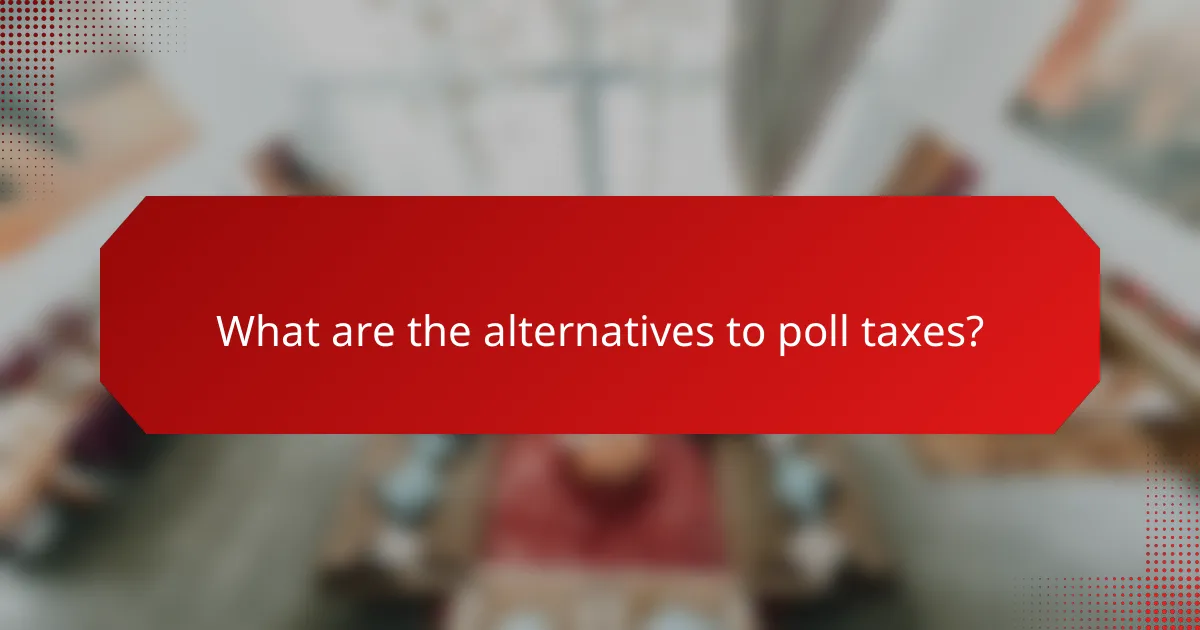
What are the alternatives to poll taxes?
Alternatives to poll taxes focus on removing financial barriers to voting, ensuring that all eligible citizens can participate in elections without economic hindrances. These alternatives include free voter registration, state-funded voting initiatives, and efforts to eliminate financial barriers in the voting process.
Free voter registration
Free voter registration allows individuals to register to vote without any associated costs, making it accessible to everyone. Many states have implemented online registration systems and same-day registration to simplify the process and encourage higher voter turnout.
To ensure you are registered, check your state’s election office website for deadlines and requirements. Some states may offer automatic voter registration when you interact with certain government agencies, such as the Department of Motor Vehicles.
State-funded voting initiatives
State-funded voting initiatives provide financial support for various aspects of the voting process, including polling place accessibility, voter education campaigns, and outreach programs. These initiatives aim to increase participation among underrepresented groups, such as low-income individuals and minorities.
Examples of state-funded initiatives include providing transportation to polling places and funding community workshops that educate voters about their rights and the voting process. States may allocate budgets specifically for these programs to enhance electoral participation.
Elimination of financial barriers in voting
Eliminating financial barriers in voting involves addressing costs associated with voting, such as transportation, time off work, and identification requirements. Policies that support paid time off for voting and subsidized transportation can help ensure that financial constraints do not prevent individuals from casting their ballots.
Advocates suggest implementing measures like universal access to mail-in ballots and reducing ID requirements to further diminish financial obstacles. By focusing on these areas, states can create a more equitable voting environment for all citizens.
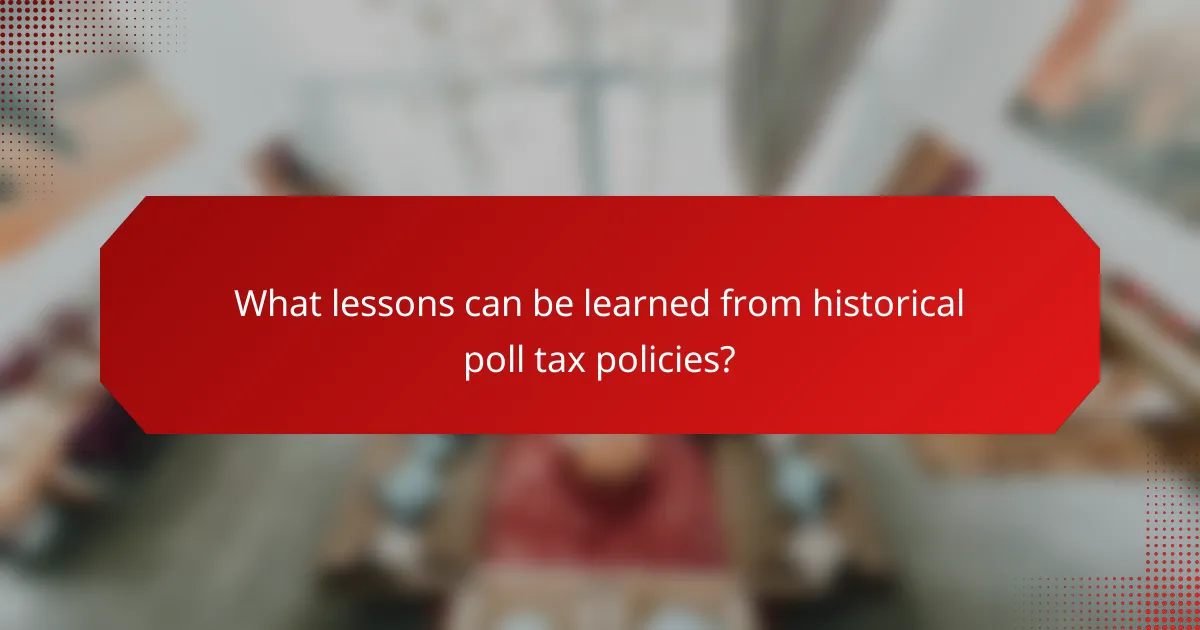
What lessons can be learned from historical poll tax policies?
Historical poll tax policies reveal significant lessons about financial barriers to voting. These taxes often disproportionately affected low-income individuals and marginalized communities, highlighting the need for equitable access to the electoral process.
Understanding systemic barriers
Systemic barriers, such as poll taxes, create obstacles that prevent certain groups from participating in elections. These barriers can include financial requirements, complicated registration processes, and discriminatory practices that target specific demographics.
For instance, in the United States, poll taxes were used primarily in Southern states to disenfranchise African American voters and poor white voters. The requirement to pay a tax to vote effectively limited access to those who could afford it, reinforcing social and economic inequalities.
To combat systemic barriers, it is crucial to advocate for policies that promote inclusive voting practices. This can include eliminating financial requirements, simplifying registration, and ensuring that all voters are informed about their rights and options.
